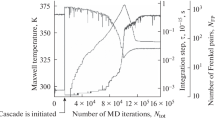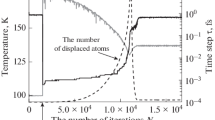Abstract
Molecular dynamics simulations of the formation and annealing of large collision cascades in delta-phase plutonium are presented. The defect evolution is followed with time up to 2 ns. Simulations are performed with the MEAM potential at three different temperatures; at 600 K where the pure delta phase is thermodynamically stable; at 300 K where the delta phase can only be maintained in a metastable state with minor additions of gallium or aluminum; and at 180 K where plutonium should transform to the alpha phase. It is found in all three cases that the atomic structure within the cascade evolves through a glass-like state. At 600 K, this structure recovers very slowly; at 300 K it persist up to 2 ns with no discernable trend to recover eventually; and at 180 K the amorphous structure initiated by the collision cascade spreads through the entire crystal and converts it to a glass-like structure.
Similar content being viewed by others
References
Jacquemin, J., Lallement, R.: Length change of α, β and δ-Pu at 1.4 K and 4.2 K. In: Miner W. N. Proc. 4th Inter. Conf. on Plutonium and other Actinides. Met. Soc. AIME, N.Y., p. 617 (1970)
Marples, J.A.C., Hough, A., Mortimer, M.J., Smith, A., Lee, J.A.: Length changes in the actinide metals due to self-irradiation damage at 4 K. In: Miner, W.N. (ed.) Proc. 4th Inter. Conf. on Plutonium and other Actinides. Met. Soc. AIME, N.Y., p. 623. (1970)
Wolfer W.G. (2000). Los Alamos Science 26: 274
Thompson, M.W.: Defects and Radiation Damage in Metals. Cambridge Univ. Press, chapter 6 (1969)
Pochet P. (2003). Modeling of aging in plutonium by molecular dynamics. Nucl. Inst. Meth. Phys. Res. B 207: 82
Daw M.S., Foiles S.M. and Baskes M.I. (1993). The embedded-atom method—A review of theory and applications. Mat. Sci. Rep. 9: 251
Baskes M.I. (2000). Atomistic model of plutonium. Phys. Rev. B 62: 15532
Moriarty J.A. (1994). Angular forces and melting in bcc transition-metals—A Case-Study of Molybdenum. Phys. Rev. B 49: 12431
Cherne F.J., Baskes M.I. and Holian B.L. (2003). Predicted transport properties of liquid plutonium. Phys. Rev. B 67: 092104
Valone S.M., Baskes M.I., Stan M., Mitchell T.E., Lawson A.C. and Sickafus K.E. (2004). Simulation of low energy cascades in fcc Pu metal at 300 K and constant volume. J. Nucl. Mater. 324: 41
Gao F., Bacon D.J., Flewitt P.E.J. and Lewis T.A. (1998). The effects of electron-phonon coupling on defect production by displacement cascades in alpha-iron. Model. Sim. Mat. Sci. Eng. 6: 543
Averback R.S. and Diazdela Rubia T. (1998). Displacement damage in irradiated metals and semiconductors. Sol. State Phys. 51: 281
Author information
Authors and Affiliations
Corresponding author
Rights and permissions
About this article
Cite this article
Kubota, A., Wolfer, W.G., Valone, S.M. et al. Collision cascades in pure δ-plutonium. J Computer-Aided Mater Des 14, 367–378 (2007). https://doi.org/10.1007/s10820-007-9057-x
Received:
Accepted:
Published:
Issue Date:
DOI: https://doi.org/10.1007/s10820-007-9057-x




